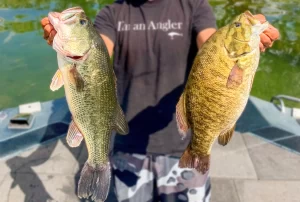Bass fishing is a popular pastime enjoyed by anglers worldwide. Two of the most sought-after species are smallmouth and largemouth bass. While they may look similar, these fish have distinct characteristics that make them unique targets. This article will delve into the key differences between smallmouth and largemouth bass, including their appearance, habitat preferences, feeding habits, and fishing techniques.
Appearance
One of the most noticeable differences between smallmouth and largemouth bass is their appearance. Smallmouth bass have smaller mouths, as their name suggests, and their heads are more pointed. They also have a darker coloration, often with a greenish-brown hue and a series of dark vertical stripes on their sides. Largemouth bass, on the other hand, have larger mouths and a rounder head shape. Their coloration varies more widely, but they typically have a brownish-green color with a dark lateral line.
Habitat Preferences
Both smallmouth and largemouth bass are freshwater fish, but they have different habitat preferences. Smallmouth bass are often found in clear, rocky waters with a moderate current. They prefer areas with structure, such as submerged logs, rocks, and ledges. Largemouth bass are more adaptable and can be found in a variety of habitats, including lakes, ponds, and rivers. They are often associated with vegetation, such as aquatic plants and lily pads.

Feeding Habits
Smallmouth and largemouth bass are both carnivores, but they have slightly different diets. Smallmouth bass are known for their aggressive feeding habits and will often chase down prey. Their diet consists primarily of small fish, crayfish, and insects. Largemouth bass are also carnivorous but are less aggressive than smallmouth bass. They are more opportunistic feeders and will eat a variety of prey, including fish, frogs, turtles, and small birds.
Fishing Techniques
The best fishing techniques for smallmouth and largemouth bass can vary depending on the conditions and the specific preferences of the fish. However, some general tips include:
- Smallmouth Bass: Use live bait, such as minnows or crayfish, or artificial lures, such as crankbaits or jigs. Target rocky areas with moderate current.
- Largemouth Bass: Use live bait, such as worms or frogs, or artificial lures, such as topwater lures or spinnerbaits. Target areas with vegetation or structure.
Smallmouth and largemouth bass are both popular targets for anglers, but they have distinct characteristics that make them unique. Understanding the differences between these two species can help you choose the right fishing techniques and increase your chances of success. Whether you prefer the aggressive feeding habits of smallmouth bass or the adaptability of largemouth bass, there’s no doubt that both species offer a rewarding fishing experience.
Image: outdoorlife





